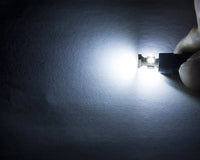First, let's talk about the commonly used LED chips for headlights/fog lights:
Philips-like Chips:
In the early days, the most famous and highly regarded LED chip for headlights and fog lights was the Philips ZES chip.
⭕: Precise focal length, distinct cut-off line.
❌: Expensive, moderate brightness.
These chips are well-known for their precise focal length and distinct cut-off line, but they are relatively expensive and offer moderate brightness.

COB Chips (CHIP ON BOARD):
Later, in an effort to reduce costs, LED headlights with COB chips became more prevalent.
⭕: Cost-effective.
❌: Low brightness, short lifespan, and most importantly, a significant issue with imprecise focal length, leading to severe glare problems!
COB chips are cost-effective but have lower brightness, shorter lifespan, and suffer from significant glare issues due to imprecise focal length.

CREE-like Chips:
These chips are characterized by a round sphere that covers the LED, resulting in even illumination and high brightness.
⭕: High brightness, even illumination.
❌: Inaccurate focal length, high cost.
Similar to CREE chips, these LEDs have a round sphere covering the chip, resulting in high brightness and even illumination. However, their focal length cannot be accurately controlled, and they come with a higher price tag.

CSP Chips (Chip Scale Package):
In recent years, LED technology has become more mature, leading to the development of the current mainstream CSP chips. There are various grades available, ranging from 1860 to 7545, with higher numbers indicating higher quality.
⭕: Precise focal length, high durability, and excellent light efficiency.
❌: While CSP chips can handle higher power, there may be concerns about potential malfunctions if heat dissipation is not sufficient.
Not only can they surpass the brightness of high-power HID lights, but they can also achieve high durability when paired with better heat dissipation and thermal management.
Only with effective heat dissipation and thermal management can LED headlights demonstrate exceptional durability.

Each LED chip type has its advantages and limitations, and their selection depends on the specific lighting application and desired performance. Proper heat management and careful consideration of the chip's characteristics are vital to achieving optimal results in automotive LED lighting.
Learn More👉The common LED chips used in general small lights, turn signals, brake lights, and reverse lights




